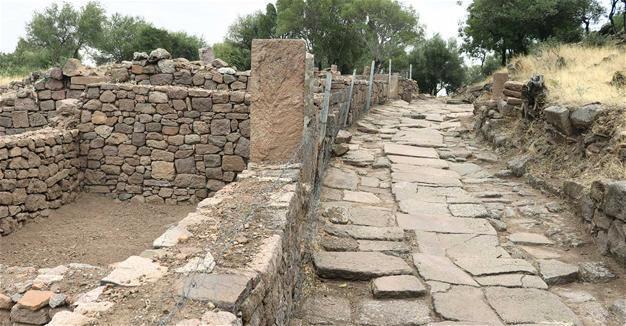Ancient road found in Manisa
MANİSA - Anadolu Agency

A road dating back to 2,000 years ago has been unearthed during the excavations in the ancient city of Aigai in the western province of Manisa.
The head of the excavations, Celal Bayar University Archaeology Department academic Yusuf Sezgin said Aigai is one of 12 cities in western Anatolia. He said that excavations have been continuing in the city since 2004, revealing civil and social life in the city.
Especially in the Hellenistic era after the third century, the city was an economic and cultural center of attraction in the region with the support of the Pergamum Kingdom, said Sezgin.
Sezgin said they found the first century Roman-era stone road during work in nearby Yuntdağı in the Yunusemre district.
“The road starts from the Aegean coast and was used 2,000 years ago between İzmir and Manisa. When we removed the earth, we found a nearly 55-kilometer road. It is interesting that the road is in good condition like it was in the past. Our examinations have revealed that water canals were constructed under the road against possible floods. We have also seen that engravings had been made on the road to prevent horses from slipping in the winter months,” he said.
Sezgin said the road served as a war route at first and was then used by caravans. He said they had developed various projects on the road.
“Maybe in the near future, visitors will be able to walk on this 2,000 year-old road. This ancient road is a system and the Roman Empire operated this system. Because, just like today, a road means civilization.
The empire should connect all cities to each other and provide transportation. This is why the system should be kept alive. Ancient resources give us information about this road. For example, there was a very important war that occurred in 190 B.C. The Roman army of 15,000 people went to Manisa from Zeytindağ through this ancient road. We are talking about a road used by the huge Roman army. The road we use today is very close to the ancient road. They are parallel to each other. It was used as a road for camels and caravans,” he said.
Sezgin said the ancient road was constructed with very fine details. He said that a thick block of rock was used in its construction, which has preserved the road so far, adding that the stones were placed using a knitting technique.
“There is a canal system under the road. This is very interesting. The Temple of Apollo is close to this road. People had a chance to pray while walking on this road,” he said.
 A road dating back to 2,000 years ago has been unearthed during the excavations in the ancient city of Aigai in the western province of Manisa.
A road dating back to 2,000 years ago has been unearthed during the excavations in the ancient city of Aigai in the western province of Manisa.